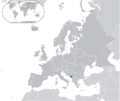Knowledge fuels change
For over a decade, Energypedia has shared free, reliable energy expertise with the world.
We’re now facing a serious funding gap.
Help keep this platform alive — your donation, big or small, truly matters!
Thank you for your support
Difference between revisions of "Montenegro Energy Situation"
***** (***** | *****) m |
***** (***** | *****) m (→Introduction) |
||
| Line 8: | Line 8: | ||
== Introduction == | == Introduction == | ||
| + | Montenegro has been making efforts to increase the share of renewable energy in its energy mix. The country has set targets and implemented policies to promote sustainable and cleaner energy sources. | ||
| + | |||
| + | Montenegro has a significant share of its electricity generated from hydropower. The country has been investing in the modernization and expansion of existing hydropower plants and the development of new ones. Has also been exploring the potential of wind energy. There have been developments in wind farm projects, with several wind farms in operation or under development. | ||
| + | |||
| + | Solar energy projects have been gaining attention, and there have been initiatives to harness solar power for electricity generation. | ||
== Energy Situation == | == Energy Situation == | ||
| + | |||
| + | === Installed electricity capacity (MW) by Technology, Grid connection and Year === | ||
| + | {| class="wikitable" | ||
| + | |+Total Installed Capacity by the end of year 2022 is 1,061.89 MW | ||
| + | !Technology | ||
| + | !Grid Connection | ||
| + | !Year | ||
| + | !Capacity (MW) | ||
| + | |- | ||
| + | |Solar photovoltaic | ||
| + | |On-grid | ||
| + | |2022 | ||
| + | |22.0 | ||
| + | |- | ||
| + | |Onshore wind energy | ||
| + | |On-grid | ||
| + | |2022 | ||
| + | |118.00 | ||
| + | |- | ||
| + | |Renewable hydropower | ||
| + | |On-grid | ||
| + | |2022 | ||
| + | |696.69 | ||
| + | |- | ||
| + | |Coal and peat | ||
| + | |On-grid | ||
| + | |2022 | ||
| + | |225.00 | ||
| + | |} | ||
== Renewable Energy == | == Renewable Energy == | ||
Revision as of 10:55, 25 October 2024
Capital:
Podgorica
Region:
Coordinates:
42.708678° N, 19.374390° E
Total Area (km²): It includes a country's total area, including areas under inland bodies of water and some coastal waterways.
XML error: Mismatched tag at line 6.
Population: It is based on the de facto definition of population, which counts all residents regardless of legal status or citizenship--except for refugees not permanently settled in the country of asylum, who are generally considered part of the population of their country of origin.
XML error: Mismatched tag at line 6. ()
Rural Population (% of total population): It refers to people living in rural areas as defined by national statistical offices. It is calculated as the difference between total population and urban population.
XML error: Mismatched tag at line 6. ()
GDP (current US$): It is the sum of gross value added by all resident producers in the economy plus any product taxes and minus any subsidies not included in the value of the products. It is calculated without making deductions for depreciation of fabricated assets or for depletion and degradation of natural resources.
XML error: Mismatched tag at line 6.2 ()
GDP Per Capita (current US$): It is gross domestic product divided by midyear population
XML error: Mismatched tag at line 6. ()
Access to Electricity (% of population): It is the percentage of population with access to electricity.
XML error: Mismatched tag at line 6.no data
Energy Imports Net (% of energy use): It is estimated as energy use less production, both measured in oil equivalents. A negative value indicates that the country is a net exporter. Energy use refers to use of primary energy before transformation to other end-use fuels, which is equal to indigenous production plus imports and stock changes, minus exports and fuels supplied to ships and aircraft engaged in international transport.
XML error: Mismatched tag at line 6.no data
Fossil Fuel Energy Consumption (% of total): It comprises coal, oil, petroleum, and natural gas products.
XML error: Mismatched tag at line 6.no data
Introduction
Montenegro has been making efforts to increase the share of renewable energy in its energy mix. The country has set targets and implemented policies to promote sustainable and cleaner energy sources.
Montenegro has a significant share of its electricity generated from hydropower. The country has been investing in the modernization and expansion of existing hydropower plants and the development of new ones. Has also been exploring the potential of wind energy. There have been developments in wind farm projects, with several wind farms in operation or under development.
Solar energy projects have been gaining attention, and there have been initiatives to harness solar power for electricity generation.
Energy Situation
Installed electricity capacity (MW) by Technology, Grid connection and Year
| Technology | Grid Connection | Year | Capacity (MW) |
|---|---|---|---|
| Solar photovoltaic | On-grid | 2022 | 22.0 |
| Onshore wind energy | On-grid | 2022 | 118.00 |
| Renewable hydropower | On-grid | 2022 | 696.69 |
| Coal and peat | On-grid | 2022 | 225.00 |





















